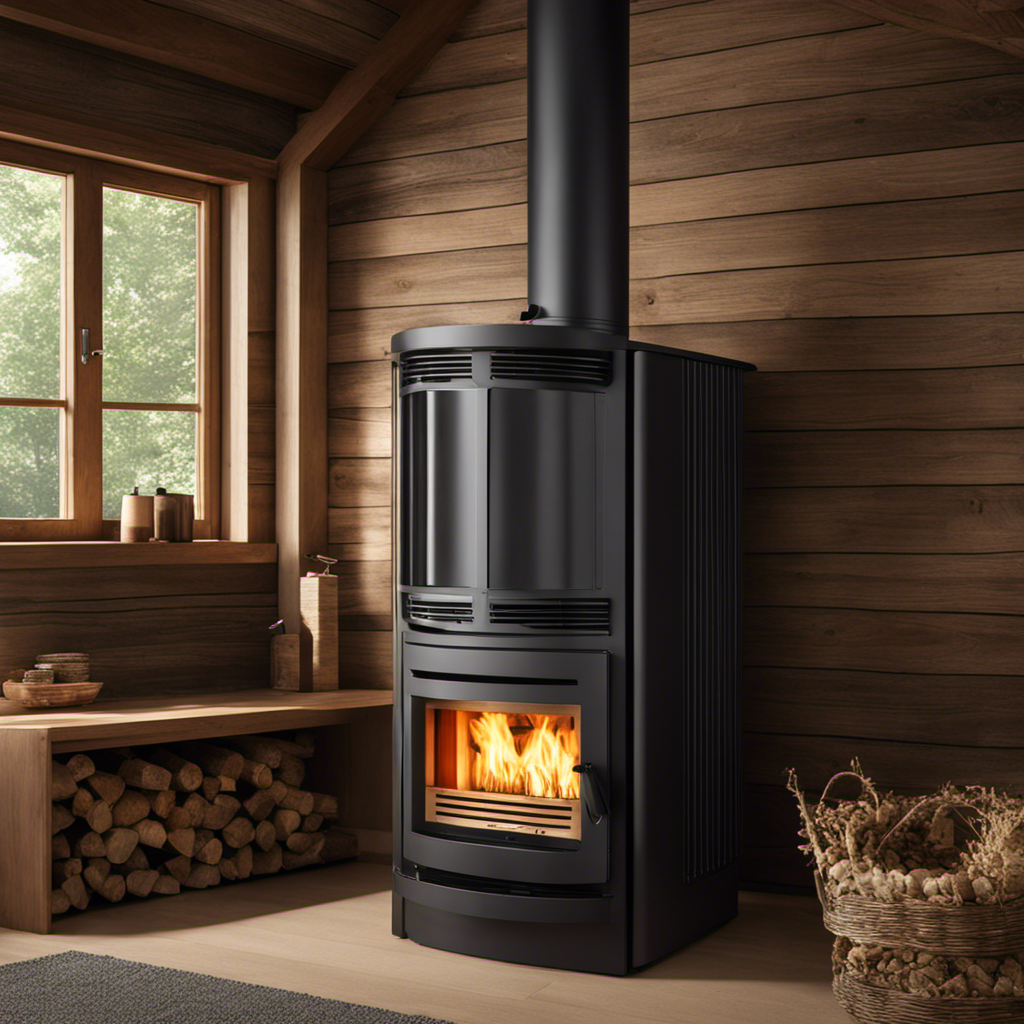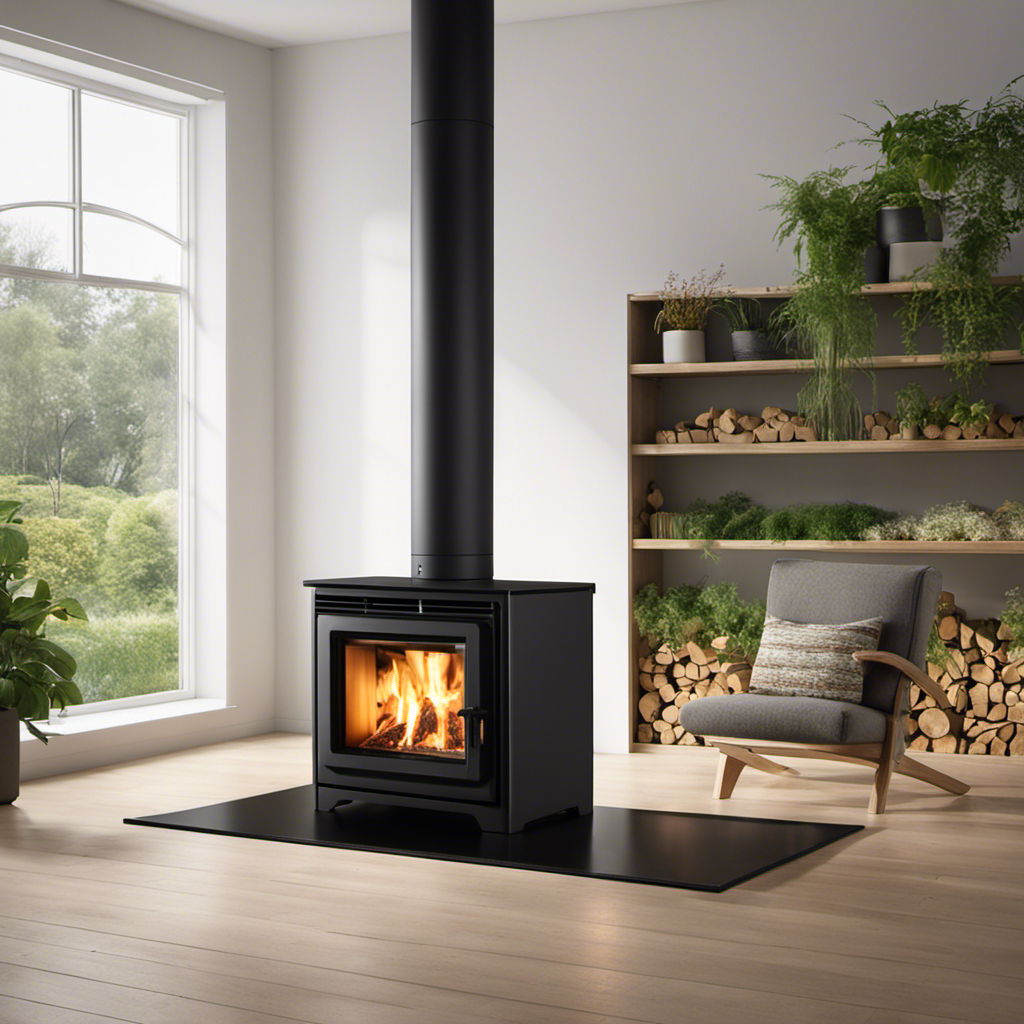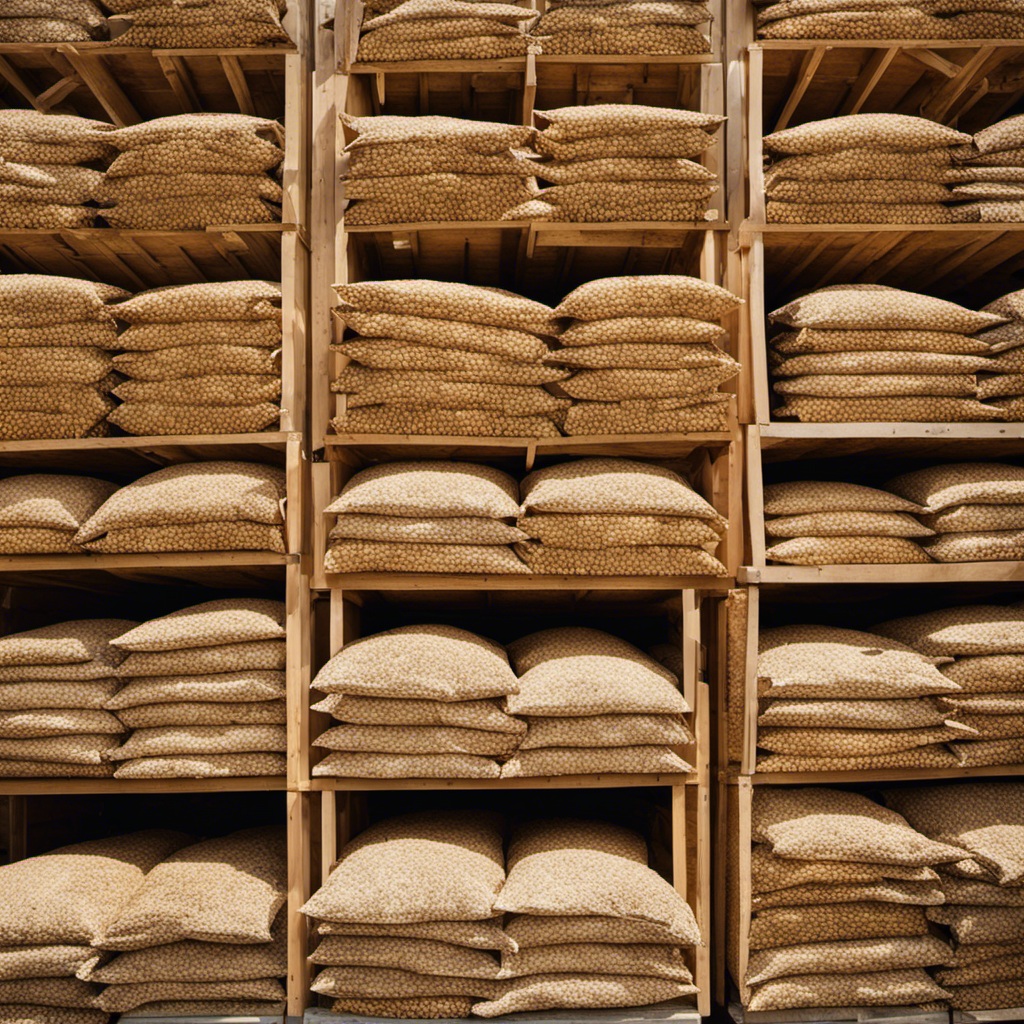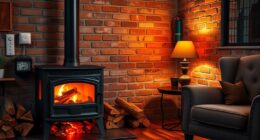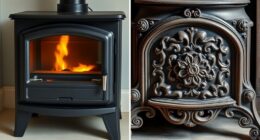As a homeowner in search of a heating solution that is both efficient and environmentally friendly, I found myself asking, “What is the mechanism behind a wood pellet stove?” Allow me to shed some light on this topic!
Wood pellet stoves utilize an ingenious combustion process to convert compressed wood pellets into cozy warmth. By understanding the components, the manufacturing of wood pellets, and the advantages of using this heating method, you’ll gain a comprehensive understanding of how these stoves operate.
So, let’s dive into the fascinating world of wood pellet stoves and unveil the secrets behind their impressive functionality.
Key Takeaways
- Wood pellet stoves were developed as a more environmentally friendly and efficient heating solution in the late 20th century.
- The main components of a wood pellet stove include the hopper, auger, combustion chamber, and exhaust system.
- Wood pellets are produced by compressing sawdust or other wood waste materials, which are then shaped into small cylindrical pellets.
- Wood pellet stoves offer efficient combustion, lower heating costs, and promote forest sustainability, making them a renewable and environmentally friendly choice.
History of Wood Pellet Stoves
You might be wondering about the history of wood pellet stoves. Well, let me take you on a journey through time to explore the evolution of these remarkable heating appliances.
The history of wood pellet stoves can be traced back to the late 20th century when the need for more environmentally friendly and efficient heating solutions arose. The concept of using compressed wood pellets as a fuel source was introduced, and with advancements in technology, the first wood pellet stoves were born.
Over the years, these stoves have undergone significant improvements in terms of efficiency, automation, and design. Today, modern wood pellet stoves are equipped with advanced features like automatic ignition, programmable thermostats, and efficient combustion systems.
Now, let’s dive into the components of a wood pellet stove, where we will explore the inner workings of this fascinating appliance.
Components of a Wood Pellet Stove
To understand the components of a wood pellet stove, take a look at how it operates.
Wood pellet stoves are designed to efficiently burn wood pellets as a source of heat. The main components of a wood pellet stove include the hopper, auger, combustion chamber, and exhaust system.
The hopper is where the wood pellets are stored and fed into the stove. The auger is responsible for transferring the pellets from the hopper to the combustion chamber.
Within the combustion chamber, the pellets are ignited and burned, producing heat. The exhaust system then vents the smoke and gases created during the combustion process.
Understanding stove mechanics is essential for using wood pellet stoves effectively. The benefits of using wood pellets include their renewable nature, low emissions, and high efficiency.
Now, let’s delve into the combustion process in wood pellet stoves.
The Combustion Process in Wood Pellet Stoves
When using a wood pellet stove, it’s important to understand how the combustion process works.
The combustion process in wood pellet stoves involves the ignition temperature and combustion efficiency.
The ignition temperature is the minimum temperature required to start the combustion process. Wood pellets have a low ignition temperature, typically around 450 degrees Fahrenheit, which makes them easy to ignite.
Once ignited, the combustion process begins, converting the wood pellets into heat energy.
The combustion efficiency refers to how effectively the wood pellets are burned. A high combustion efficiency means that a larger percentage of the fuel’s energy is converted into heat, resulting in less waste.
Understanding the combustion process and ensuring a high combustion efficiency is crucial for maximizing the heat output and minimizing fuel consumption in wood pellet stoves.
Now, let’s explore how wood pellets are made.
How Wood Pellets Are Made
The process of making wood pellets involves compressing sawdust or other wood waste materials into small pellets using high heat and pressure.
Wood pellet production begins with collecting and drying the raw materials, which are then finely ground into sawdust.
The sawdust is then fed into a pellet mill, where it is exposed to heat and pressure. The heat softens the lignin present in the wood, which acts as a natural glue, binding the wood particles together.
As the sawdust passes through the die of the pellet mill, it is compressed and shaped into small cylindrical pellets.
These pellets are then cooled and screened to remove any fines.
Wood pellets are a sustainable and renewable source of energy, as they are made from waste materials. They have several benefits, including high energy density, low moisture content, and reduced greenhouse gas emissions.
Transitioning into the subsequent section, let’s explore the advantages of using a wood pellet stove.
Advantages of Using a Wood Pellet Stove
Using a wood pellet stove can significantly reduce heating costs and lower carbon emissions. Here are three advantages of using a wood pellet stove and the positive environmental impact it can have:
-
Efficient combustion: Wood pellet stoves are designed to burn wood pellets at a high temperature, resulting in complete combustion and minimal waste. This efficiency ensures that more heat is produced and less fuel is needed, leading to lower heating costs.
-
Renewable fuel source: Wood pellets are made from compressed sawdust and other wood byproducts, making them a sustainable and renewable fuel source. Unlike fossil fuels, wood pellets can be produced from waste materials, reducing the demand for new trees and promoting forest sustainability.
-
Reduced carbon emissions: Compared to traditional heating systems, wood pellet stoves release significantly fewer carbon emissions into the atmosphere. This reduction in greenhouse gases helps mitigate climate change and improve air quality, making wood pellet stoves a more environmentally friendly heating option.
Understanding the ignition system of a wood pellet stove is crucial for safe and efficient operation.
Understanding the Ignition System
When it comes to the operation of a wood pellet stove, understanding the ignition process is crucial.
The ignition process is the initial step that starts the combustion of the pellets, ultimately providing heat.
Proper ignition is of utmost importance as it ensures efficient and safe operation of the stove, preventing issues such as incomplete combustion or the release of harmful gases.
Ignition Process Explained
To start the ignition process in a wood pellet stove, you simply press the power button.
Wood pellet stoves typically have two main ignition methods: automatic and manual.
In automatic ignition, a built-in igniter heats up the pellets until they reach their ignition point. This method is convenient and efficient, ensuring a reliable start every time.
On the other hand, manual ignition requires the user to ignite the pellets using an external heat source, such as a lighter or a torch. Although less common, this method is useful in case of power outages or when the automatic ignition system malfunctions.
When troubleshooting ignition issues, it is important to check the igniter for any damage or debris buildup, and also ensure that the fuel supply is sufficient.
Proper ignition is crucial for efficient and safe operation of a wood pellet stove, as it ensures complete combustion and minimizes the release of harmful emissions.
Importance of Proper Ignition
Make sure you press the power button correctly to ensure a proper ignition in your wood pellet stove.
Proper ignition techniques are crucial for the efficient operation of your stove.
If you encounter any issues during the ignition process, troubleshooting them is essential to prevent potential problems.
To troubleshoot ignition issues, first, ensure that the stove is plugged in and the power button is pressed firmly.
Check the electrical connections for any loose or damaged wires.
Clean the burn pot, as a dirty pot can hinder ignition.
Make sure there is an adequate supply of pellets in the hopper and that the air intake and exhaust vents are clear of any obstructions.
By following these proper ignition techniques and troubleshooting any issues, you can ensure a smooth start to your wood pellet stove.
Now, let’s move on to controlling heat output in a wood pellet stove.
Controlling Heat Output in a Wood Pellet Stove
You can adjust the heat output on a wood pellet stove by using the control panel. Controlling heat distribution is an important aspect of optimizing the performance of your stove.
The control panel allows you to set the desired temperature and regulate the amount of fuel being burned. If you find that the heat output is too low, you can increase it by adjusting the temperature settings or increasing the feed rate. On the other hand, if the heat output is too high, you can decrease it by lowering the temperature or reducing the feed rate.
Troubleshooting heat output issues may involve checking the thermostat, inspecting the auger system, or cleaning the stove to ensure proper airflow. By understanding how to control heat output, you can create a comfortable and efficient heating environment in your home.
Now, let’s move on to maintenance and cleaning tips for wood pellet stoves.
Maintenance and Cleaning Tips for Wood Pellet Stoves
Regular maintenance is essential for keeping your wood pellet stove operating efficiently. Here are some maintenance tips and cleaning techniques to help you keep your stove in top condition:
- Cleaning the burn pot and ash pan regularly is crucial to ensure proper airflow and combustion efficiency.
- Check and clean the exhaust vent regularly to prevent blockage and ensure proper ventilation.
- Use a chimney brush to remove any soot or creosote buildup inside the vent.
- Inspect the gaskets and seals around the door and glass for any signs of wear or damage, and replace if necessary.
- Clean the glass window regularly using a non-abrasive cleaner to maintain a clear view of the fire.
- Lubricate the moving parts, such as the blower motor and auger, to prevent friction and ensure smooth operation.
By following these maintenance tips and cleaning techniques, you can keep your wood pellet stove in optimal condition and enhance its performance.
Now, let’s explore the environmental impact of wood pellet stoves.
Environmental Impact of Wood Pellet Stoves
Now, let’s explore how wood pellet stoves affect the environment. Wood pellet stoves are an excellent choice for those looking to reduce their carbon footprint and make use of renewable energy sources. These stoves burn wood pellets, which are made from compressed sawdust and other wood waste materials. Compared to traditional heating options, wood pellet stoves produce significantly fewer carbon emissions, making them a more environmentally friendly choice. To illustrate this, let’s take a look at the following table:
| Heating Options | Carbon Emissions |
|---|---|
| Wood Pellet Stoves | Low |
| Oil/Gas Furnaces | High |
| Electric Heaters | High |
| Coal Stoves | High |
| Propane Heaters | High |
As you can see, wood pellet stoves have the lowest carbon emissions among these heating options. This makes them a sustainable and eco-friendly choice for heating your home.
In the next section, we will compare wood pellet stoves to other heating options, highlighting their advantages and benefits.
Comparing Wood Pellet Stoves to Other Heating Options
Now that we have discussed the environmental impact of wood pellet stoves, let’s compare them to other heating options, specifically traditional fireplaces.
Wood pellet stoves offer several advantages over traditional fireplaces. Firstly, they are more cost-effective in terms of fuel efficiency. Wood pellets are denser and burn more efficiently than traditional firewood, providing more heat with less waste. This results in lower fuel costs and reduced environmental impact.
Additionally, wood pellet stoves are safer and more convenient to use. Unlike traditional fireplaces, they have automatic ignition and temperature control features, eliminating the need for constant monitoring. They also produce less smoke and particulate matter, improving indoor air quality.
Overall, when considering the cost-effectiveness and convenience, wood pellet stoves are a superior option compared to traditional fireplaces.
What Makes Wood Pellet Stoves and Wood Pellet Burners Different in How They Work?
Wood pellet stoves and wood pellet burners differ in their operational mechanisms. Wood pellet burner operation involves a more complex process, where the burner is integrated into a central heating system to provide heat throughout the entire house. Meanwhile, wood pellet stoves are designed to heat a specific room or area.
Is a Wood Pellet Burner the Same as a Wood Pellet Stove?
Yes, a wood pellet burner and a wood pellet stove are essentially the same thing. Both use a wood pellet burner operation to ignite and produce heat. They have similar features and work in the same way to burn wood pellets efficiently and provide warmth for residential and commercial spaces.
Frequently Asked Questions
Can I Use Regular Firewood in a Wood Pellet Stove?
No, you cannot use regular firewood in a wood pellet stove. Wood pellet stoves are specifically designed to burn wood pellets, which have a higher energy content and produce less ash than traditional firewood. Using wood pellets in a wood pellet stove offers several benefits, such as improved efficiency and cleaner combustion.
How Often Do I Need to Clean the Ash From My Wood Pellet Stove?
I usually clean the ash from my wood pellet stove every 1-2 weeks. It’s important to dispose of the ash properly to prevent any fire hazards. Regular cleaning helps maintain the stove’s efficiency and prolong its lifespan.
Are Wood Pellet Stoves Safe for Indoor Use?
Wood pellet stoves offer several advantages for indoor use, such as efficient heating and reduced emissions compared to traditional wood-burning stoves. However, disadvantages include the need for electricity and regular maintenance to ensure safe operation.
Can I Use Wood Pellets Made From Different Types of Wood in My Stove?
Yes, you can use wood pellets made from different types of wood in your stove. Different woods have varying heat outputs and burn rates, so it’s important to consider the advantages and disadvantages of each type.
How Much Do Wood Pellet Stoves Cost to Operate Compared to Other Heating Options?
Compared to other heating options, wood pellet stoves cost less to operate due to their high energy efficiency. They offer a cost-effective solution for heating your home while reducing your overall energy expenses.
Conclusion
In conclusion, after diving deep into the mechanics and functionality of wood pellet stoves, it is clear that these heating devices are not only efficient but also environmentally friendly.
The intricate combustion process, combined with the use of carefully crafted wood pellets, ensures optimal heat output and minimal waste.
With proper maintenance and cleaning, these stoves can provide reliable warmth for years to come.
Compared to other heating options, wood pellet stoves stand out as a sustainable and cost-effective choice.
So, if you’re considering a heating upgrade, don’t overlook the benefits of a wood pellet stove.

